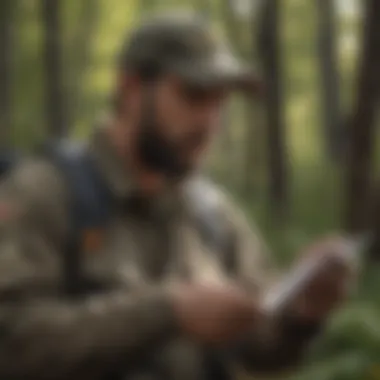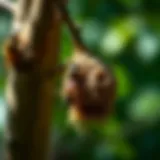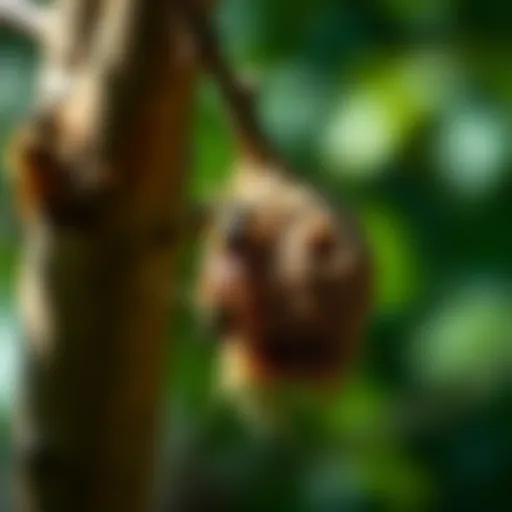Pocono Wildlife Control: Challenges and Solutions


Intro
In the Pocono region, wildlife encounters are common due to the area's rich natural landscapes. Understanding how to manage these interactions is essential for homeowners and residents. This article examines the challenges and solutions related to wildlife control in the Poconos. It covers essential topics such as identifying common pests, cleanup strategies, and humane treatment methods.
Pest Identification
Effective wildlife control begins with the recognition of different species. Some common pests in the Pocono area include raccoons, deer, and various rodent species.
Detailed Descriptions of Common Pests
- Raccoons: Characterized by their masked face and ringed tail, raccoons are scavengers. They often rummage through trash and can cause property damage.
- Deer: While graceful, deer can become a nuisance by consuming gardens and landscaping.
- Rodents: Mice and rats are often found in attics and garages. They reproduce quickly and can pose health risks.
Signs and Symptoms of Infestations
Identifying signs of a wildlife problem is crucial. Common indicators include:
- Droppings in areas where wildlife is active.
- Nests or burrows, particularly in quiet, concealed spots around the home.
- Damaged vegetation, especially if bites or hoofprints are visible around gardens.
Prevention Strategies
Preventing wildlife intrusion is often simpler and more effective than dealing with infestations.
Home Maintenance Tips for Pest Prevention
Regular maintenance can discourage wildlife. Consider the following actions:
- Seal openings in walls, roofs, and foundations.
- Secure trash bins with tight lids.
- Remove food sources, like pet food or bird feeders during certain seasons.
Natural Deterrents and Barriers
Utilizing natural deterrents can be effective in keeping wildlife at bay. Some options include:
- Planting certain herbs like rosemary, which may repel animals.
- Using motion-activated sprinklers to surprise and scare away unwanted fauna.
Treatment Options
When prevention fails, treatment becomes necessary. Understanding the options is key to responsible wildlife management.
Overview of Chemical vs. Natural Treatments
Homeowners have a variety of treatment options. Chemical solutions can be effective but may have environmental repercussions. Natural treatments are often safer, promoting a humane approach.
Step-by-Step Guides for DIY Treatments
Some DIY methods include:
- Trapping: Use humane traps to capture unwanted animals for re-release.
- Repairing entry points: After removal, fix any damage to prevent re-entry.
- Check local regulations regarding trapping.
Ensure to handle all wildlife interactions with caution and care. Safety should always come first.
To summarize, effective wildlife control in the Pocono region requires a clear understanding of pest behavior, preventive measures, and treatment options. By adopting responsible strategies, homeowners can protect their property and maintain harmony with local fauna.
Understanding Wildlife Control
Wildlife control refers to the methods used to manage and mitigate interactions between humans and wildlife. In the Pocono region, this topic is particularly important due to the area's diverse animal population, which can create significant challenges for homeowners. Understanding the nuances of wildlife control goes beyond merely handling nuisance animals; it encompasses prevention, management, and ethical treatment of the wildlife that shares space with us.
Definition and Scope
The definition of wildlife control involves various techniques used to address the presence of wildlife in residential and commercial areas. This includes managing populations of species that may pose risks to property, health, or safety. The scope of wildlife control can be divided into several categories: monitoring animal behavior, implementing preventative strategies, and enacting control measures when necessary. Notably, a comprehensive approach to wildlife control balances the need for human safety and welfare while respecting the natural environment.


Importance of Wildlife Control
Effective wildlife control is crucial for several reasons. Firstly, it helps to protect properties from potential damage caused by wildlife. For example, raccoons can cause extensive damage to roofs and attics while searching for nesting sites. Secondly, managing wildlife populations can mitigate health risks associated with zoonotic diseases. Animals like deer and geese can harbor ticks and bacteria that affect human health. Lastly, understanding and implementing wildlife control contributes to community safety. Minimizing human-wildlife interactions helps reduce conflicts, ensuring that both people and animals can coexist in harmony.
"Proper wildlife control not only protects homes but also fosters a respectful relationship between humans and the natural world."
By grasping the significance of wildlife control, homeowners can equip themselves with the knowledge to manage these important issues effectively. Whether it's by understanding the behavior of local wildlife species or adopting humane management practices, informed individuals can significantly reduce risks and promote a balance in their environment.
Common Wildlife in Pocono
Understanding the common wildlife in the Pocono region is essential for effective wildlife control. The rich biodiversity in this area contributes not only to the ecosystem but also presents specific challenges for homeowners. Identifying which animals inhabit the region helps inform appropriate management strategies, promoting a harmonious coexistence between humans and wildlife. The presence of various species affects local flora, daily activities of residents, and the overall health of the community. By understanding these species, homeowners can make informed decisions about prevention and control methods.
Mammals
Raccoons
Raccoons are highly adaptable mammals often encountered in the Pocono area. They have a distinctive black mask over their eyes and rings on their tails. These features make them easily recognizable. Raccoons can be beneficial in terms of managing pest populations, such as insects. However, their opportunistic feeding habits can lead to them raiding garbage bins and bird feeders, causing disturbance. It's important to properly secure trash and other food sources to deter these animals from approaching residential areas. They are also known carriers of rabies, which is a significant concern for public health. Therefore, knowing their behavior can help mitigate risks.
Squirrels
Squirrels, particularly the Eastern gray squirrel, are common in this region. They are distinguished by their bushy tails and agile climbing skills. These mammals play a crucial role in the ecosystem by dispersing seeds. This is beneficial for maintaining plant diversity. However, their tendency to gnaw on wires and invade attics can lead to property damage. Homeowners should take preventative measures to secure entry points and maintain a well-kept yard to limit access. Their playful nature can also contribute to human enjoyment of nature, despite the potential nuisance they may cause.
Deer
White-tailed deer are an iconic species of the Pocono Mountains. They are known for their graceful movements and distinctive antlers in males during the breeding season. While deer contribute to the beauty of the landscape, they can also cause significant damage to gardens and landscapes. Their presence can attract predators and lead to increased accidents involving vehicles, especially during dusk and dawn. Homeowners may consider deer-resistant plant choices and physical barriers to protect their properties. Understanding deer behavior, including their feeding patterns, can assist in managing their impact on local ecosystems.
Foxes
Red foxes are another species often seen in this area. They are noted for their bushy tails and sharp features. Foxes play a vital role in controlling small mammal populations. They help balance the ecosystem but can also pose challenges by preying on backyard pets. Their presence can also indicate a healthy environment. Homeowners may need to take specific actions, such as keeping pets indoors or using fencing, to safeguard against potential threats. Recognizing foxes' behaviors and territory can help in prevention strategies.
Birds
Woodpeckers
Woodpeckers, identifiable by their pecking behavior on trees to find insects, are an integral part of the Pocono wildlife. Their role in controlling insect populations is significant. They also assist in the health of aging trees, helping to create habitats for other wildlife. However, their pecking can sometimes be seen as a nuisance when they target houses. Implementing deterrents, such as reflective surfaces, can help mitigate the damage they cause.
Starlings
Starlings are aggressive birds that can form large flocks. They are known for their iridescent feathers and ability to mimic sounds. Their large gatherings can lead to considerable mess and noise, impacting local residents. Understanding starling behavior can help in strategies such as habitat modification to discourage nesting in unwanted areas. However, their social behaviors can also be charming and add to the local avifauna.
Geese
Canada geese are prevalent in the Pocono area, especially near water bodies. They have distinct black heads and are known for their honking calls. While they are beautiful birds, they can create problems with their droppings and aggressive behavior during nesting seasons. Implementing strategies to prevent nesting in yards, such as setting up barriers, can help control their presence. Their seasonal migration patterns also impact local ecosystems, which is an important consideration for wildlife control.
Reptiles and Amphibians
Snakes
Snakes, such as garter snakes and black rat snakes, contribute to controlling pest populations. They are often misunderstood, and many people fear them unnecessarily. In fact, most snakes are non-venomous and play a valuable role in biodiversity. Understanding their habits can help alleviate concerns. Homeowners can benefit from creating snake-friendly environments, promoting a balanced ecosystem while protecting their property at the same time. However, caution is advised near species like the timber rattlesnake, as they are venomous and can be harmful.
Frogs
Frogs, particularly the American toad, are crucial for pest control, as they feed on insects. Their presence is often seen as a sign of a healthy environment, as they are sensitive to pollution. Yet, their calls during mating seasons can be loud and disruptive. Maintaining a healthy garden ecosystem can enhance frog populations, providing natural pest control. However, their breeding needs should be considered and protected, as habitat loss poses significant risks.
Understanding the common wildlife in Pocono is vital for effective management practices. Residents can create a healthier coexistence with local wildlife through informed decisions.
Challenges in Wildlife Control
Wildlife control in the Pocono region presents numerous challenges that can significantly impact local communities. Understanding these challenges is essential for effective management and for ensuring that human interactions with wildlife are both safe and humane. Factors such as seasonal changes, urbanization, and conflicts with wildlife require dedicated strategies. Addressing these issues not only aids in protecting residential areas but also promotes ecological balance.
Seasonal Considerations


Weather plays a prominent role in wildlife behavior and, consequently, in wildlife control strategies. Different seasons bring specific activities of wildlife that require attention. For example, during spring and summer, animals like raccoons and squirrels are more active as they seek nesting sites for their young. In contrast, fall may see an influx of deer as they search for food and mating partners. Winter often drives animals to seek shelter in residential areas, increasing the likelihood of human-wildlife interactions.
Understanding these seasonal patterns is key for homeowners. They should implement preventive measures before animals become a nuisance. Proper waste management and securing entry points around homes can greatly reduce unwanted wildlife visits. Recognizing seasonal trends will better equip residents to avoid problems, ultimately creating a safer, more harmonious community.
Urban Encroachment
As urban areas expand, interactions with wildlife become inevitable. The Pocono region is not exempt from this urban sprawl. The encroachment of human settlements disrupts traditional wildlife habitats. Animals are often driven into neighborhoods in search of food and shelter. This shift poses various challenges, as many urban designs do not account for the ecological needs of local wildlife.
Community engagement is vital in this context. Local governments and residents can collaborate to create solutions that respect both human and wildlife needs. This may include establishing green spaces, wildlife corridors, and landscaping that discourage unwelcome wildlife from entering homes. Effective communication among stakeholders can foster a greater understanding of wildlife behavior, enhancing coexistence.
Human-Wildlife Conflict
Conflicts between humans and wildlife can result in significant challenges. As animals adapt to urban living, their behavior can lead to property damage, health risks, and safety issues. For instance, encounters with deer can lead to vehicle accidents, while raccoons rummaging through trash can pose sanitation problems.
Understanding the root causes of these conflicts is essential. Homeowners must educate themselves about the species in their area. Recognizing the behaviors that lead to conflicts can aid in taking preventive actions. This includes securing garbage cans, avoiding feeding animals, and using proper fencing to keep out potentially problematic creatures. By doing so, tensions can be diffused, promoting a peaceful coexistence with local wildlife.
"Understanding wildlife behavior is key to reducing conflicts. Adopt proactive measures to coexist with local fauna."
Strategies for Effective Control
Strategies for effective control are crucial to managing wildlife in the Pocono region. This involves not just responding to existing wildlife problems, but implementing proactive measures to prevent conflicts. These strategies aim to mitigate the risks that wildlife poses to human safety and property in this area. Effective control can minimize damage, reduce health risks, and encourage a healthier coexistence between humans and local fauna.
Prevention Techniques
Exclusion Methods
Exclusion methods focus on preventing wildlife from entering homes and properties. This strategy is based on the simple belief that if animals cannot gain access, problems will not arise. Key characteristics of exclusion methods include physical barriers like fences, sealing entry points, and using screens on vents and windows.
The main unique feature of exclusion methods is their long-term effectiveness. Once correctly implemented, these procedures can prevent a variety of animals from entering structures. However, it's important to note that there can be some disadvantages. Costs can accrue from labor and materials, and improper installation could still allow wildlife access.
Sanitation Practices
Sanitation practices involve cleaning and maintaining areas to eliminate food sources that wildlife might find inviting. This includes proper waste disposal, secure storage of food items, and thorough yard maintenance. The main aim is to reduce the attractants that draw wildlife to residential areas.
Sanitation practices are a beneficial choice in wildlife control because they address the core issue: the attraction to human resources. The unique aspect of sanitation is that it not only serves to prevent unwanted visitors but also improves the overall cleanliness of the area. On the downside, it can require ongoing effort and vigilance from homeowners to ensure that these standards are consistently met.
Humane Trapping Methods
Humane trapping methods are essential in managing wildlife populations without causing them harm. These techniques are designed to capture animals safely and without injury, allowing for relocation instead of extermination. The key characteristic here is the humane aspect. It ensures that animals are treated ethically while also addressing the homeowner's needs. A potential disadvantage is that trapping might not be effective for all species, and follow-up relocation efforts can be necessary.
Repellents and Deterrents
Repellents and deterrents play a significant role in wildlife control strategies. They are designed to keep animals away from certain areas without harming them. This can be particularly important for households that prefer non-lethal solutions.
Natural Repellents
Natural repellents include substances that deter wildlife through scent or taste. Examples are citronella, garlic, or certain essential oils. Their key characteristic is that they use ingredients derived from nature, which is appealing to environmentally conscious homeowners. The unique feature of natural repellents is their safety for use around pets and children. However, their effectiveness can vary based on the species and their persistence may require frequent reapplication.
Chemical Deterrents
Chemical deterrents are synthetic products that prevent wildlife from entering specific areas. They may include odor-based repellents that create an environment unpleasant for animals. The principal characteristic of these products is their targeted effectiveness. Chemical deterrents can work fast and often require less frequent application compared to natural options. Nonetheless, they can pose risks to other wildlife and pets if not used correctly, which is a major consideration for any homeowner.
Using a combination of these strategies can lead to better outcomes when managing wildlife issues. While individual techniques have their advantages and drawbacks, together they create a more comprehensive approach to wildlife control in the Pocono region.
Legal and Ethical Considerations
Understanding the legal and ethical considerations surrounding wildlife control is crucial for effective and responsible management of local fauna. This section emphasizes not only the principles of humane treatment but also the legal frameworks that guide wildlife interactions. Being informed about these aspects helps homeowners and wildlife control professionals navigate complex situations with an appropriate balance of responsibility and respect for both human and animal populations.
Local Regulations
Local regulations are established by various governmental bodies at state, county, and municipal levels. They address wildlife control methods, specific animal management policies, and the responsibilities of homeowners and professionals. For example, in the Pocono region, regulations might dictate:


- Permissible Wildlife Control Methods: Some methods of control may be restricted or regulated to prevent cruelty to animals. There are often guidelines on traps and baits that can be used.
- Reporting Requirements: Homeowners may be required to report certain wildlife interactions, especially if they involve endangered species or any exotic animals.
- Seasonal Restrictions: Certain periods might have restrictions based on mating seasons or migration patterns, which protect wildlife during vulnerable times.
Staying informed about these regulations minimizes legal risks and promotes a more strategic approach to wildlife management.
Humane Treatment Laws
The humane treatment of wildlife is a fundamental component governing wildlife control practices. Humane treatment laws aim to protect animals from inhumane practices during control measures. These laws typically mandate that any wildlife encountered must be treated humanely and kindly, ensuring:
- Proper Handling: Professionals must follow guidelines to handle animals with care, minimizing stress and suffering.
- Ethical Trapping and Release: Methods used for trapping must not only comply with local regulations but also adhere to humane standards. Improper trapping can lead to injury or distress for the animal.
- Non-lethal Solutions: Encouraging non-lethal options where feasible is a critical component of wildlife management. This might include relocation or habitat modification instead of extermination.
Adhering to humane treatment laws promotes ethical wildlife control practices that are vital for sustainable coexistence. Furthermore, being knowledgeable about these laws fosters a community-wide commitment to preserving the ecological balance.
"Adhering to regulations is not just about compliance; it's about fostering a responsible approach to much-needed wildlife management."
By embracing both legal frameworks and ethical guidelines, residents in the Pocono region can ensure a dynamic balance between human needs and wildlife conservation.
Professional Wildlife Control Services
Wildlife control is a vital aspect of maintaining a balanced and safe living environment in Pocono. The significance of professional services in this field cannot be overstated. These experts bring specific skills and knowledge that enable them to address diverse issues posed by wildlife intrusions effectively. Understanding when to hire professionals and how to choose the right services is essential for homeowners who value both the safety of their property and the humane treatment of animals.
When to Hire a Professional
There are various circumstances that prompt homeowners to seek the assistance of professional wildlife control services. When wildlife becomes a nuisance or presents health risks, it is critical to take action. Common signs that indicate a need for professional help include:
- Visible damage to property, such as chewed wires or structural harm.
- Observations of animals behaving aggressively or erratically.
- Presence of droppings, tracks, or nests inside or close to the home.
- Persistent noises in attics or walls during nighttime.
While some minor wildlife issues can be addressed through preventive measures, consulting with experts is prudent when the situation escalates. Professional wildlife control services ensure that removal is conducted humanely, adhering to regulatory standards.
How to Choose a Service
Choosing the right wildlife control service is crucial for effective management. Several factors must be taken into consideration to make an informed decision. Two essential aspects in the selection process include research and service standards.
Research and Referrals
Engaging in thorough research and obtaining referrals can significantly enhance the search for a qualified wildlife control service. When looking for a professional, consider the following:
- Key Characteristics: Seeking referrals from neighbors or local online communities can yield trustworthy recommendations. Many homeowners are happy to share their experiences with various services they have used.
- Unique Feature: A reputable service will often have positive testimonials or case studies available. This transparency is advantageous, as it provides insights into their effectiveness and customer satisfaction level.
By relying on personal recommendations, homeowners can feel more confident about their choices, ensuring they select a service committed to humane practices while effectively addressing their wildlife problems.
Service Standards
Another critical element when choosing a wildlife control service is understanding their compliance with service standards. The standards typically include licensing, certifications, and an ethical approach to wildlife management. Focus on the following points:
- Key Characteristic: Look for companies that clearly communicate their methodologies and the treatments they use. A professional service will provide details on how they plan to handle the specific wildlife issues.
- Unique Feature: The service should adhere to local regulations governing wildlife handling. This ensures not only compliance but also safety and humane treatment of the animals involved.
In regions like Pocono, where interactions with diverse wildlife are common, selecting a service that prioritizes ethical treatment while meeting industry standards provides peace of mind to homeowners without compromising their safety.
Conclusion: Professional wildlife control services play a pivotal role in maintaining the balance between human living spaces and local fauna. By understanding when to seek help and how to choose effectively, homeowners can protect their property without causing harm to wildlife.
Closure and Future Directions
Wildlife control in the Pocono region is not merely a reactive stance to problematic fauna. Instead, it encapsulates a multidimensional approach aimed at creating harmony between humans and wildlife. This section serves as a pivotal recap and foresight into how control strategies can evolve alongside changing ecological dynamics and societal expectations.
Summary of Key Points
This article has highlighted several essential points regarding wildlife control in the Pocono area:
- Diverse Wildlife: The Pocono area is home to a variety of species, each with unique challenges and considerations for management.
- Control Challenges: Seasonal changes and urban encroachment complicate effective wildlife control, often leading to human-wildlife conflicts.
- Strategies for Management: Emphasis was placed on humane trapping, exclusion methods, and the use of repellents to ensure that the wildlife remains safe while protecting property and health.
- Legal and Ethical Standards: Understanding local regulations and humane treatment laws establishes a baseline for proper wildlife control practices.
- Professional Involvement: Knowing when to hire professionals is crucial in ensuring effective and safe wildlife management techniques are employed.
"Effective wildlife control requires not just immediate action, but also foresight in planning and implementation of ecologically sustainable practices."
Ongoing Research and Adaptation
The field of wildlife control must remain fluid and adaptable. Continuous research plays a vital role in refining control methods and understanding species behavior. Several key areas deserve attention for future exploration:
- Effect of Climate Change: Monitoring how climate shifts impact local wildlife populations can inform better control practices.
- Technological Advancements: Innovations in tracking and trapping technologies could enhance humane control methods, making them more efficient.
- Community Education: Ongoing educational programs may help in fostering a better understanding among homeowners about cohabitation practices, significantly reducing conflicts.
- Biodiversity Conservation: Research into the ecological impact of wildlife control measures ensures that efforts align with conservation goals.
In summation, wildlife control in the Pocono region is a dynamic interplay of responsibilities. By understanding current methodologies and looking ahead, we can foster a safer coexistence with local wildlife while safeguarding our communities.



